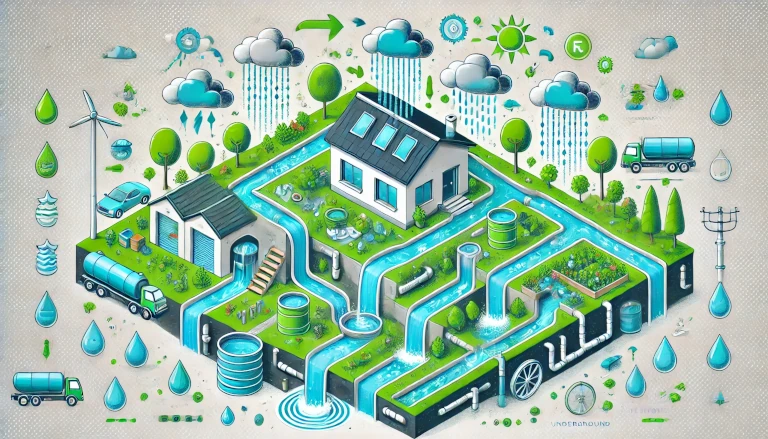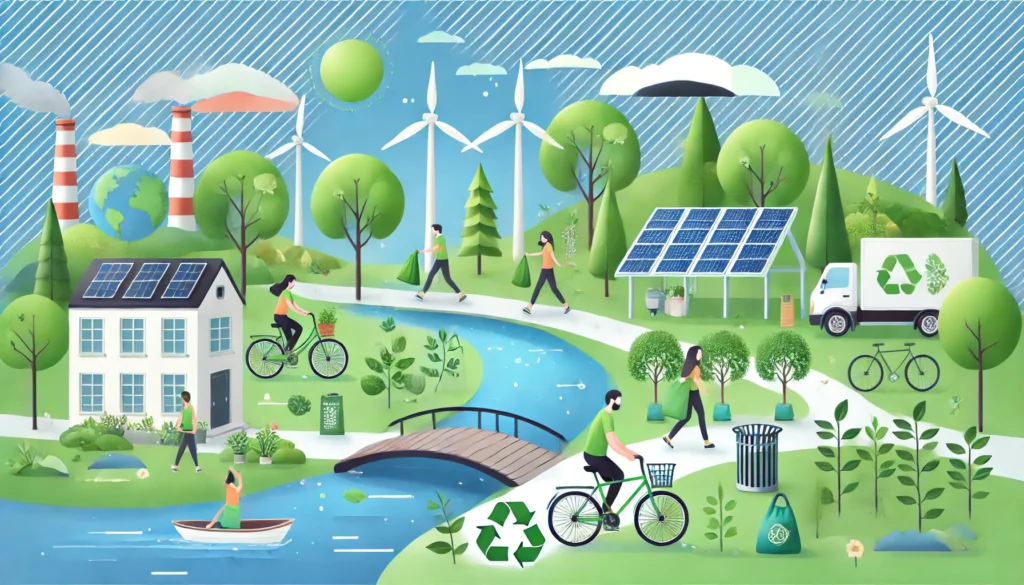Rainwater harvesting is an easy and effective way to collect and store rainwater for future use. In a world where water scarcity is becoming a growing concern, this method provides a sustainable solution for conserving water and reducing our reliance on traditional water sources. Whether it’s for household use, agriculture, or landscaping, rainwater harvesting can play a key role in addressing the global water crisis.
In this blog, we will explain what rainwater harvesting is, why it’s important, and how you can implement it in your home or community.
What is Rainwater Harvesting? 🌧️🏡
Rainwater harvesting is the practice of collecting and storing rainwater from rooftops, driveways, or other hard surfaces for later use. Instead of letting rainwater flow off into drains or streets, rainwater harvesting systems capture the water and store it in tanks, underground reservoirs, or barrels. This water can then be used for various purposes such as irrigation, gardening, cleaning, and even drinking if properly treated.
Why is Rainwater Harvesting Important? 💧🌍
Rainwater harvesting has several benefits, making it an essential practice in both urban and rural areas. Here’s why it’s important:
1. Conserves Water 💧
Rainwater harvesting helps reduce our dependence on groundwater and municipal water supplies. By using rainwater for non-drinking purposes like watering plants, cleaning, and flushing toilets, we can conserve precious freshwater resources.
2. Reduces Flooding and Soil Erosion 🌳🌦️
By capturing and storing rainwater, rainwater harvesting helps prevent flooding during heavy rains and reduces the risk of soil erosion. It helps manage water runoff, especially in urban areas where concrete surfaces prevent water from being absorbed into the ground.
3. Improves Groundwater Levels 🌍🌿
In regions facing groundwater depletion, rainwater harvesting systems can help recharge underground water sources. By allowing rainwater to seep into the ground, it replenishes aquifers and maintains water tables.
4. Cost-Effective Water Supply 🏠💰
Rainwater harvesting can significantly reduce your water bills by providing an alternative water source for daily tasks. Installing a rainwater harvesting system is a one-time investment that can save money in the long run.
5. Self-Sufficient Water Supply 🚿🌧️
In areas where water supply is inconsistent or restricted, rainwater harvesting ensures a reliable source of water. During droughts or water shortages, having stored rainwater can provide a lifeline for basic needs.
Types of Rainwater Harvesting Systems 🌧️🏡
There are various ways to collect and store rainwater, depending on your needs and location. Here are two main types of rainwater harvesting systems:
1. Rooftop Rainwater Harvesting 🏠🌧️
This is one of the most common methods of rainwater harvesting, where rainwater is collected from rooftops and channeled through gutters into storage tanks or underground reservoirs. The stored water can be used for household chores, gardening, or even purified for drinking.
- Example: A homeowner installs a rooftop rainwater harvesting system with gutters that channel rainwater into a 1000-liter tank for use in the garden.
2. Surface Runoff Harvesting 🌳🌧️
In surface runoff harvesting, rainwater is collected from driveways, streets, or other surfaces and stored in large underground tanks or reservoirs. This is especially useful in areas with heavy rainfall and urban environments with paved surfaces.
- Example: A community installs a system that collects rainwater from roads and sidewalks into an underground storage unit, which is then used for irrigation in public parks.
How to Set Up a Simple Rainwater Harvesting System 🛠️🌿
Setting up a basic rainwater harvesting system at home is easier than you might think. Here’s how to do it:
1. Choose a Collection Surface 🏠
The most common surface for collecting rainwater is the roof. Make sure the roof is made of non-toxic materials to ensure the water is safe for non-potable uses.
2. Install Gutters and Downspouts 🛠️
Install gutters along the edge of your roof to catch rainwater and downspouts to direct the water into a storage tank or barrel.
3. Select a Storage Container 🚰
Choose a water storage tank that suits your needs. For smaller systems, a rain barrel (50–100 gallons) may be sufficient. For larger systems, install underground tanks or reservoirs for greater storage capacity.
4. Add a Filtration System 🧼💧
Install a basic filter to remove debris such as leaves, dirt, and twigs from the collected water. If you plan to use the water for drinking, additional filtration and treatment will be necessary to ensure the water is safe.
5. Distribute the Water 🚿🌧️
Use a pump system to distribute the stored rainwater where it’s needed. You can connect the tank to your garden irrigation system, toilets, or outdoor faucets for easy access.
Real-World Example: Rainwater Harvesting in India 🌧️🇮🇳
India has been using rainwater harvesting for centuries as a way to cope with water scarcity, especially in rural and drought-prone areas. Cities like Chennai have implemented rainwater harvesting systems in homes and public buildings to combat water shortages. In many villages, community-based rainwater harvesting has helped improve groundwater levels and provide farmers with water for irrigation.
Benefits of Rainwater Harvesting for Communities 🌍💧
Rainwater harvesting isn’t just for individuals; it can benefit entire communities:
- Improves water security: Communities that harvest rainwater are less dependent on external water sources and can better manage during droughts or water shortages.
- Reduces infrastructure costs: By collecting rainwater, the need for expensive water treatment and distribution systems can be reduced.
- Promotes sustainability: Communities that practice rainwater harvesting help reduce water waste, conserve natural resources, and create a more sustainable water supply.
Conclusion: Start Harvesting Rainwater to Conserve Water 🌧️💧
Rainwater harvesting is a simple yet powerful solution to conserving water and ensuring a reliable water supply for the future. Whether it’s for household use, agriculture, or community benefit, capturing rainwater helps reduce our reliance on traditional water sources, protects against water scarcity, and promotes sustainability.
By taking small steps to collect and store rainwater, we can all contribute to the global effort to conserve water and protect the environment. It’s time to embrace this eco-friendly practice and ensure a greener, more sustainable future for generations to come.
Discover more from Green Ecosystem - Renewable Energy, Agriculture, and Environmental Sustainability
Subscribe to get the latest posts sent to your email.


